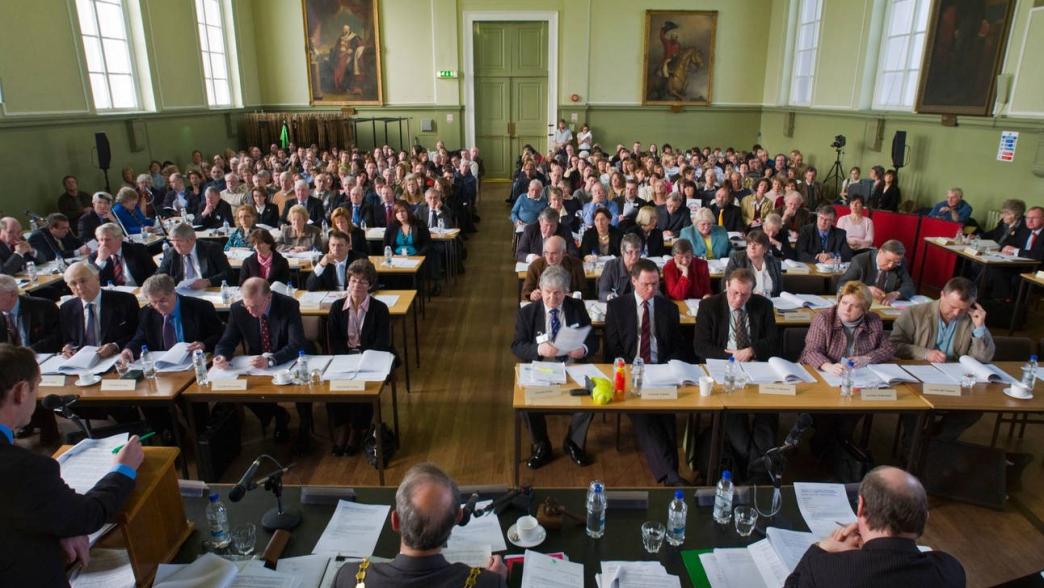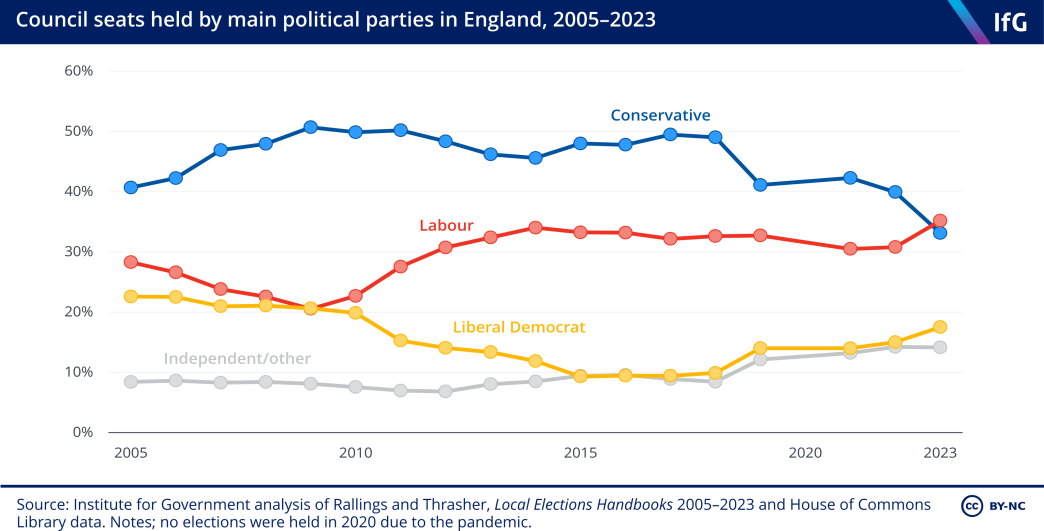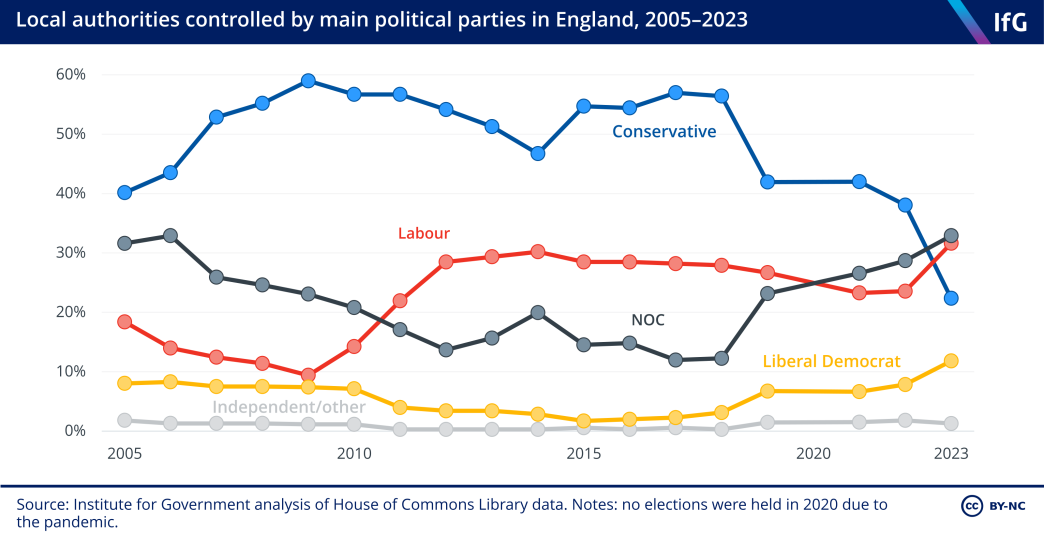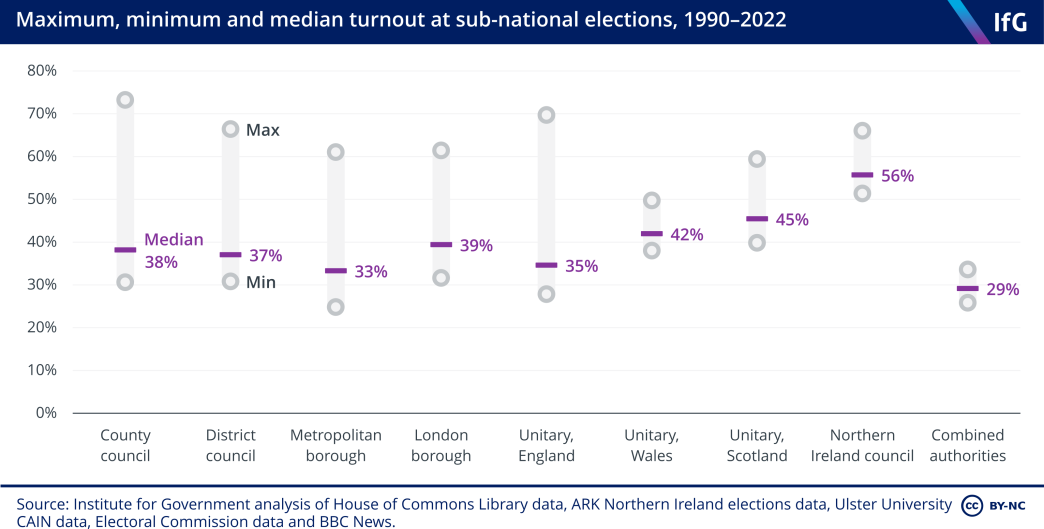Local elections 2024: District, borough and unitary councils
On 2 May voters across England will elect more than 2,500 councillors

This Thursday, local elections will take place in many parts of England.
Where are elections taking place?
Scheduled elections are being held in 107 of England’s 317 councils this Thursday (2 May 2024).
- Four unitary authorities
- Three metropolitan boroughs
- 20 district councils
A third of seats will be contested in:
- 14 unitary authorities
- 28 metropolitan boroughs
- 34 district councils
Half of the seats will be contested in four district councils.
One local authority mayoral election will take place, in Salford, Greater Manchester (this is distinct from the Greater Manchester Combined Authority mayoral election taking place on the same day). This election will take place under the first past the post electoral system, following the implementation of the Elections Act 2022.
There are also an estimated 48 council by-elections taking place on the same day.
Who controls the councils up for election?
Of the 107 councils holding elections, 73 have a single-party majority:
- 45 are Labour-run
- 18 are Conservative-run
- 10 are Liberal Democrat-run
The remaining 34 are under no overall control. In these cases either a minority administration or a coalition of several parties runs the council. Of these 34 councils:
- Seven have Labour leaders
- Eight have Conservative leaders
- Ten have Liberal Democrat leaders
- One has a Green leader
- Nine are led by other parties.
In nine cases, the party with the most seats does not lead the council.
How many seats are being contested in England?
A total of 2,636 council seats are being contested in the 107 scheduled council elections and 48 by-elections being held on the same day. 24 Bobbi Westerman, What’s up for election in 2024?, democracy club, 11 March 2024, retrieved 10 April 2024, https://democracyclub.org.uk/blog/2024/03/11/whats-up-for-election-in-2024/
Unlike in the other three UK nations, not all council elections in England take place in the same year. Two thirds of councils elect all their councillors every four years (67%), just under a third elect councillors by thirds three years out of every four (31%), and a far smaller number elect their councillors by halves every two years (2%).
In 2024, one sixth of the total number (16,181) of council seats in England are being contested.
In England, councillors are elected on four-year terms to single or multi-member wards using the first past the post electoral system.
What is the current state of the parties at local government level?
After the May 2023 local elections, the Conservative Party held 33% of all council seats in England, down seven percentage points from 2022. The Labour Party held 35%, up 4% from the previous year, and the Liberal Democrats 18%, up 3% from the previous year. Labour became the party with the largest share of council seats in England for the first time since 2002.
What is the current state of the parties at local government level?
After the May 2023 local elections, the Conservative Party held 33% of all council seats in England, down seven percentage points from 2022. The Labour Party held 35%, up 4% from the previous year, and the Liberal Democrats 18%, up 3% from the previous year. Labour became the party with the largest share of council seats in England for the first time since 2002. 25 Edmund Tetteh, ‘Councillors and Council Control: 1979:2009’, House of Commons library, 6 April 2010, retrieved 12 April 2024, https://researchbriefings.files.parliament.uk/documents/SN05376/SN05376.pdf

Following those elections, the Conservative Party controlled 70 of councils (22%), down 56 from the 126 they had held in 2022. The Labour Party controlled 99 councils (32%) and the Liberal Democrats 37 (12%). Councillors from other parties and independents controlled four councils. The remaining 103 councils were under no overall control.

Most of the seats being contested in 2024 were last up for election in 2021, having been postponed from 2020 due to the pandemic. 26 This in effect reduced the term of these councillors from four years to three years. To read more on this see Neil Johnston “Coronavirus: elections”, House of Commons Library, Briefing paper number 08856, 14 April 2021, https://researchbriefings.files.parliament.uk/documents/CBP-8856/CBP-8856.pdf At those elections, the Conservatives received an estimated national equivalent share of the vote of 40%, 27 This is a figure which estimates the vote share parties would have received had elections been carried out across all local authorities. For more details on this see ‘National share of the vote’ in Elise Uberoi ‘Local elections 2023: Results and analysis’, House of Commons Library, 22 May 2023, retrieved 11 April 2024, https://researchbriefings.files.parliament.uk/documents/CBP-9798/CBP-9798.pdf the Labour 30% and the Liberal Democrats 15%. 28 Richard Cracknell, Elise Uberoi, Matthew Burton, UK Election Statistics: 1918-2023, a long century of elections, House of Commons Library, 9 August 2023, retrieved 10 April 2024, https://researchbriefings.files.parliament.uk/documents/CBP-7529/CBP-7529.pdf
Why do these elections matter?
Many frontline public services are delivered by local councils. In England, district councils in two-tier local government areas provide local services such as planning, housing, leisure and recycling services.
Unitary councils and metropolitan boroughs provide these functions as well as other services such as social care, waste management and aspects of transport and education.
In England, local authorities spent £59.4bn (net current expenditure) on public services in 2022/23. The largest spending areas were adult social care (£20.5bn) and children’s social care (£12.8bn). 33 DLUHC, Revenue outturn service expenditure summary (RSX) 2022 to 2023, 14 February 2024, retrieved 12 April 2024, www.gov.uk/government/statistics/local-authority-revenue-expenditure-and-financing-england-2022-to-2023-individual-local-authority-data-outturn
Many local authorities face financial pressures due to a decade of funding cuts, recent high inflation and increasing demand, which have led several councils to file section 114 notices – effectively declaring bankruptcy – with others too at risk.
In some parts of England, local leaders also hold collective responsibility for powers – for instance over transport, skills and economic development – that are devolved to combined authorities that operate across several council areas and are led by metro mayors.
Who can vote in local council elections?
In England all adults aged 18 and over can vote in local elections if they are British citizens, EU citizens, or ‘qualifying Commonwealth citizens’ 34 https://www.gov.uk/elections-in-the-uk/local-government (citizens of Commonwealth countries who have leave to enter or remain in the UK, or who do not require that leave). 35 https://www.electoralcommission.org.uk/i-am-a/voter/register-vote-and-update-your-details#commonwealth
Following the passage of the Elections Act 2022, the local elections on 2 May will take place with mandatory voter identification (ID) in England. Voters will need to show an acceptable form of photographic ID, as listed on the Electoral Commission website. Voters without photo ID can apply for a voter identification certificate until 24 April 2024 to enable them to vote. 36 https://www.electoralcommission.org.uk/voting-and-elections/voter-id/applying-a-voter-authority-certificate
Voter ID requirements only apply to votes cast at polling stations; postal votes use different, pre-existing, signature verification.
How many people vote in local elections?
Fewer people vote in local elections than in general elections. Local turnout tends to be between 30-40% of the electorate. By contrast, turnout for elections to the UK parliament over the past five elections has averaged 66%. When local elections take place at the same time as parliamentary elections, as last happened in England in 2015, turnout is comparable to that of national elections.

- Political party
- Conservative Labour Liberal Democrat Green Party
- Project
- Local and mayoral elections 2024
- Publisher
- Institute for Government